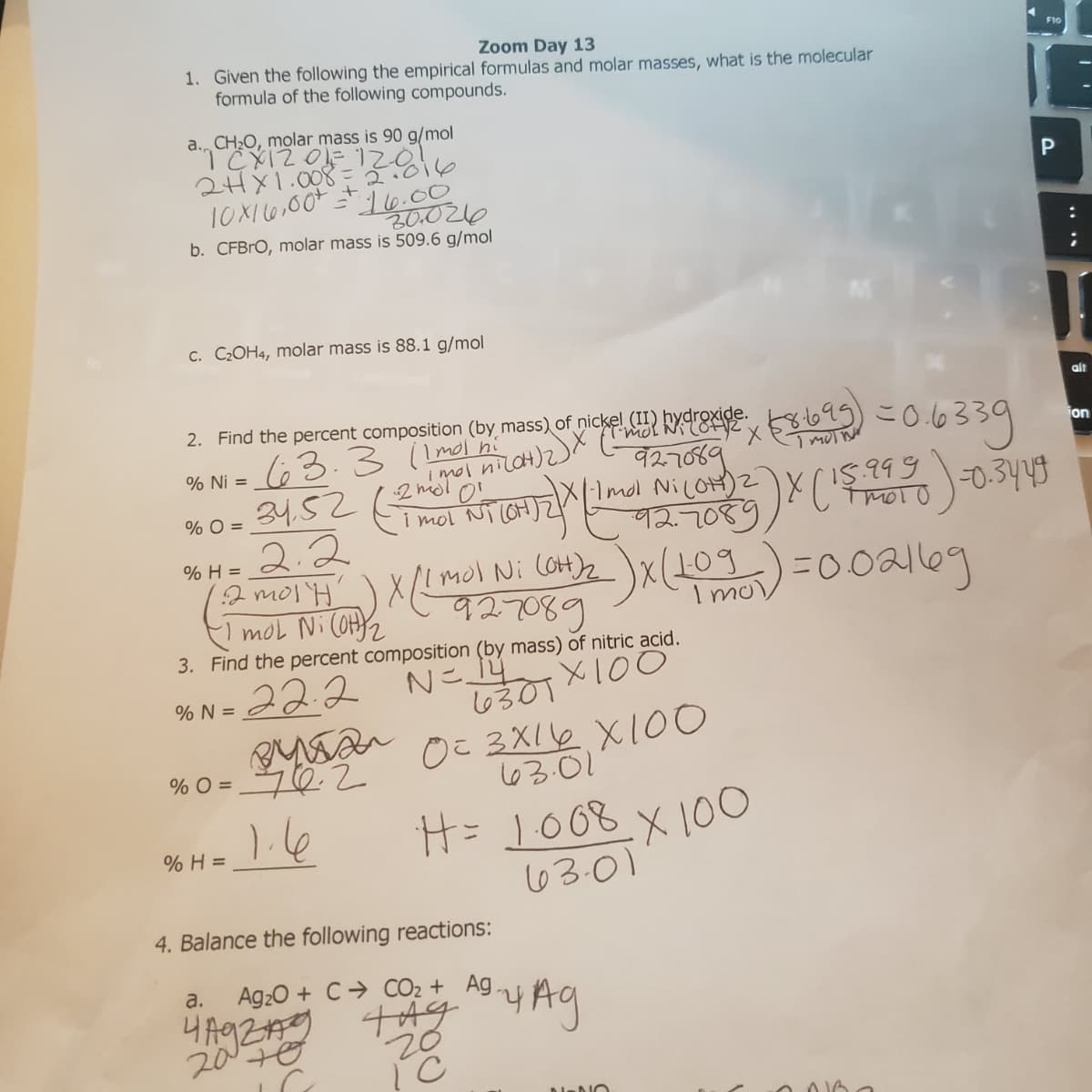Chemical Principles in the Laboratory
11th Edition
ISBN:9781305264434
Author:Emil Slowinski, Wayne C. Wolsey, Robert Rossi
Publisher:Emil Slowinski, Wayne C. Wolsey, Robert Rossi
Chapter4: Determination Of A Chemical Formula
Section: Chapter Questions
Problem 2ASA: If one can find the ratio of the number of moles of the elements in a compound to one another, one...
Related questions
Question
Question 1 need b and c to be answered

Transcribed Image Text:Zoom Day 13
1. Given the following the empirical formulas and molar masses, what is the molecular
formula of the following compounds.
a. CH2O, molar mass is 90 g/mol
2HX1.008 = T.016
P
10X16,00+
16.00
20.026
b. CFBRO, molar mass is 509.6 g/mol
C. C2OH4, molar mass is 88.1 g/mol
alt
2. Find the percent composition (by mass) of nickel kyE 581695)
63.3 ( Imol n
こ0639
jon
927089
% Ni =
% O =
I5.999
i mol Ni cOH)
92.7089
2.2
12 morH mol xl109
mol Ni COH2
% H =
Ni COH)2
I mo
3. Find the percent composition (by mass) of nitric acid.
Nこ.
6301X100
○こ3XI2 X100
22.2
% N =
% O =
63.01
H= 1008.X10O
6301
% H =
4. Balance the following reactions:
a.
Ag20 + C→ CO2 + Ag,
Expert Solution
This question has been solved!
Explore an expertly crafted, step-by-step solution for a thorough understanding of key concepts.
This is a popular solution!
Trending now
This is a popular solution!
Step by step
Solved in 2 steps with 1 images

Knowledge Booster
Learn more about
Need a deep-dive on the concept behind this application? Look no further. Learn more about this topic, chemistry and related others by exploring similar questions and additional content below.Recommended textbooks for you

Chemical Principles in the Laboratory
Chemistry
ISBN:
9781305264434
Author:
Emil Slowinski, Wayne C. Wolsey, Robert Rossi
Publisher:
Brooks Cole

Introductory Chemistry: A Foundation
Chemistry
ISBN:
9781337399425
Author:
Steven S. Zumdahl, Donald J. DeCoste
Publisher:
Cengage Learning

Chemistry by OpenStax (2015-05-04)
Chemistry
ISBN:
9781938168390
Author:
Klaus Theopold, Richard H Langley, Paul Flowers, William R. Robinson, Mark Blaser
Publisher:
OpenStax

Chemical Principles in the Laboratory
Chemistry
ISBN:
9781305264434
Author:
Emil Slowinski, Wayne C. Wolsey, Robert Rossi
Publisher:
Brooks Cole

Introductory Chemistry: A Foundation
Chemistry
ISBN:
9781337399425
Author:
Steven S. Zumdahl, Donald J. DeCoste
Publisher:
Cengage Learning

Chemistry by OpenStax (2015-05-04)
Chemistry
ISBN:
9781938168390
Author:
Klaus Theopold, Richard H Langley, Paul Flowers, William R. Robinson, Mark Blaser
Publisher:
OpenStax


Chemistry & Chemical Reactivity
Chemistry
ISBN:
9781337399074
Author:
John C. Kotz, Paul M. Treichel, John Townsend, David Treichel
Publisher:
Cengage Learning

Chemistry: Principles and Reactions
Chemistry
ISBN:
9781305079373
Author:
William L. Masterton, Cecile N. Hurley
Publisher:
Cengage Learning